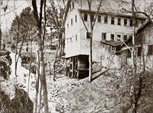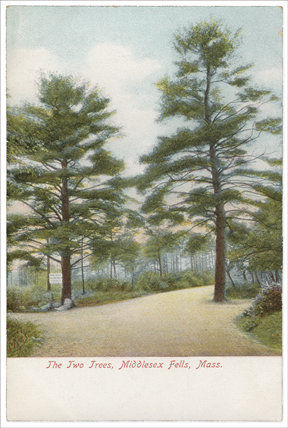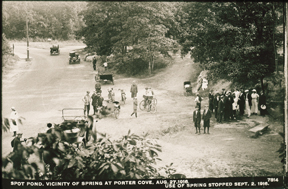its early years the park was managed to maintain (and create) a variety of landscapes. The Sheepfold was grazed by sheep to maintain a pastoral scene: there were 26 animals in 1909. In 1910 a new electric trolley ran from Somerville to Stoneham, stopping at the Sheepfold (tracks and bridges can still be seen there). This greatly increased visitation. In the same year the wooden observation tower built by the Appalachian Mountain Club at Bear Hill was redesigned by the firm of Stickney and Austin and constructed of reinforced concrete.
Between 1919 and 1930 over one half million trees were planted for scenic purposes as well as maintaining water quality in the Reservoirs. Roads, shelters, trails and other conveniences were maintained by laborers and patrolled by police officers. The park was maintained as a recreation area for the urban public. In the 1930s the Civilian Conservation Corps (CCC) and the Works Progress Administration (WPA), designed to relieve unemployment during the Great Depression, worked in the park. Gypsy Moths were sprayed (with little long term effect), and ‘improvements ’ were made to trails, roads, Bellevue Pond and Spot Pond Brook. Wright's Tower (located on Pine Hill), paid for by Elizur Wright's family to commemorate his work for the Fells, was built by the WPA.
During the 1950s through 1960s intensive recreation sites were built by the MDC, including a soap box derby track in the Sheepfold, a swimming pool, and skating rink.
The zoo in the Fells began as early 1900, with a collection of local animals. The facility was improved over time so that non-native species and facilities for breeding could be incorporated. Visitation in the 1950s became high enough so that Walter D. Stone was named to direct the Franklin Park and Middlesex Fells Zoos. The Fells zoo was named for him after he died in an automobile accident.
The single largest change to the Fells during this period of park management was the construction of Route 93 in the 1960s. It effectively cut the park in two for both the pedestrian, visitor and wildlife. The increase in noise, air and water pollution from automobiles has had an undocumented, but real effect on the reservation.
As a management agency the MPC went through many changes. In 1919 it became the Metropolitan District Commission (MDC) when it was given responsibility for providing water and sewer services. In 1970 a Parks and Recreation Division was created, which focused on facilities such as skating rinks and swimming pools. In that same year the Reservations and Historic Sites Division was created to manage natural and cultural areas. These changes had direct effects on the park. The goal of the division has been to maintain the natural characteristics of the reservations while offering recreational opportunities to the urban public. The trail map and associated trail work, is one of the result of those efforts. Another result has been an emphasis on cultural resources. In 1992 Spot Pond Brook was listed in the National Register of Historic Places as an Archaeological District for its role in water powered industry.
The effects of geological and biological forces, along with thousands of years of human impact has made the Fells a unique natural and cultural site in the metropolitan area.
Much more detail about natural features and history of the Fells can be found on the obverse of the map which is free when you join the Friends or can be purchased from the Friends. The text for this page was taken from this map.
The Friends pamphlet Creation
of the Middlesex Fells, written
by MIke Ryan, can be found
here or purchased as a print copy.
Development continued to divide the Fells. Between 1874 and 1880 the Winchester Reservoirs were built by impounding existing wetlands. They cover an area of 198 acres. Public access to the reservoirs was prohibited in 1934.
Spot Pond was considered as a source of water as early as 1825. Its 296 acres finally became a part of the metropolitan water system in 1989. Contributing to this system was the Middlesex Fells reservoir (aka High Service Reservoir), made by impounding a wetland, which was constructed in 1899, and the Bear Hill reservoir, completed in 1901.
Ice cut from Spot, Doleful, and Wright's Pond were part of New England's flourishing ice industry during the second half of the 19th century. Of the many ice companies on these ponds Frederic Tudor's was most significant. He developed a storage system for ice that reduced the rate of melting, allowing ice to be transported within the U.S. and to international markets, such as the Caribbean, South America, and India.
Park Management
Public support for creating a park in the area of the Fells began as early as 1869. Elizur Wright, a successful business man and "father" of the life insurance industry, advocated that ‘Five Mile Wood’, as it was known then, become a park for metropolitan Boston. Wright proposed special natural history schools be developed, purchased property in and around Pine Hill for conservation as well as his residence, and was instrumental in passage of the Public Domain Act, allowing cities and towns to preserve and establish forests. In 1888 the Medford Public Domain Club was organized to support the creation of a public park. While interest remained in creating a park, nothing more substantial happened for five years.
architect with a
vision of a
metropolitan park
system, helped to
create the Trustees of Reservations. The first gift to this trust was Virginia Wood, which is now within the Fells (see photo to left). Donated by the Tudor family in the name of their daughter who was killed in a riding accident, a plaque commemorates this first public piece of the Fells.
Then in 1892, through the efforts of concerned citizens, the Trustees, and the Appalachian Mountain Club, with Eliot's leadership the state legislature created the Metropolitan Parks Commission (MPC). Here you may view the text of Charles Eliot's first report to the MPC in which he lays out his vision for the metropolitan park system we have today. This resource contains text, illustrations and maps. Charles Eliot was a protege of famed landscape architect F. L. Olmsted; here is a review of how Olmsted's vision influenced creation of the Fells Reservation.
The Fells was one of the first of many properties that the MPC considered as metropolitan parks. In 1894, 450 acres were taken. By 1897 the park was over 3000 acres including 1200 acres of water bodies, 13 miles of wood roads, eight miles of town road, farms, private estates and the Langwood Hotel. A half million dollars was allocated to create pleasure roads, called parkways, to link the public to each of the newly created parks. On May 1st 1894 Charles Eliot began planning the first of these parkways, to connect the Fells with the center of the district, according to historical records [see Charles Eliot - Landscape Architect, written by Charles' father, Charles W. Eliot].
The natural and cultural history of the Fells begins after the retreat of the glaciers during the last Ice Age. When the ice melted, plants and animals colonized the landscape. Not far behind were people who used, and adapted to, this new environment. As the climate continued to warm, plant and animal species changed. This meant new resources available to people. At the same time, technological advances allowed Native Americans, and then Europeans, to use natural resources in different ways. This in turn effected the flora and fauna.
In 1725 Stoneham
was incorporated
making the town
a major land owner
of the Fells area. In
1753 Medford
expanded into the
Fells; Melrose and Winchester were incorporated in 1850. By 1880 the political subdivisions were in the same place as they are today.
The Fells area was common land for timber and pasture before it began to be divided. As subdivisions continued, farming remained important in two areas of the Fells - north and west of Spot Pond. In and around the Stone Zoo was a farming area that operated for over 200 years under a variety of families. Farming ceased there when the Metropolitan Parks Commission (MPC) took the land in 1894 to create the Fells Reservation. Similarly, in and around the Sheepfold section of the Fells, farms were operated by a variety of families from 1700s through to the purchase of the land by these farm meadows after it became a reservation. The name comes from the building where the sheep were kept.
Beginning in the 1830s through 1870s, the Pine Hill area was quarried for diabase, a dark rock used for gravel and construction. The gravel was used in the 1840s and 1850s for paths in the Boston Common and Gardens. Many of the mansions that were built around Spot Pond were built from this stone. The quarries can still be seen on the northwest side of Pine Hill, along Quarry Road. In a similar vein, between 1881 and 1883 F. W. Morandi attempted a mining operation near a small hill between Spot Pond and the Winchester Reservoirs. In his first effort he excavated $18 in silver and $4 in gold. The site is now known as the Silver Mine. It was capped for safety reasons by the MDC in 1936.
The land around Spot Pond was subdivided in the 1840s when Boston businessmen planned to sell picturesque waterfront lots. The venture was a success. Many wealthy families built their summer and full time homes there. Today, only the house of John Botume, Jr. remains, on Woodland Road. It is an Italianate building, constructed with rock from the Medford quarries. Placed on the National Register of Historic Places in 1984, it is now used as office space and a Fells Reservation Visitor Center.

HISTORY OF THE MIDDLESEX FELLS
 | ||||

The first sub- division of the Fells did not occur until
1658. East-west
range lines
(stonewalls) were
built in what is now the Medford section for the purpose of dividing the land for woodlots. The area around Spot Pond Brook was also subdivided. Records indicate James Barrett owned a sawmill there as early as 1706. By 1715 he had sold a portion of his property, and industrial subdivisions continued for over 150 years. The Red Mill situated on Spot Pond Brook is shown at the left. Click Fells Trails to find trails you may want to explore in the area.






Courtesy MDC Archives
Spot Pond Vicinity of Spring at Porter Cove, Aug. 27, 1916. Spring use discontinued Sept. 2, 1916.